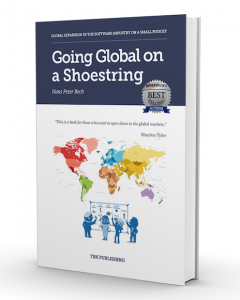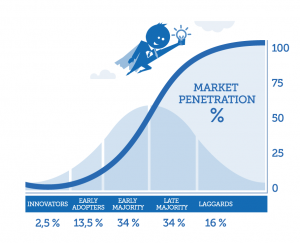Eight Questions About Global Expansion in the Software Industry
I believe small companies need to spend more time thinking, researching and planning before they execute. And when they execute, I want them to think of it as an experiment rather than the final count-down to the hole-in-one event. Test-adjust-test-adjust-test-adjust.
When it comes to embarking on international expansion, people make the same mistakes again and again.
Because of media distortion, people are led to believe that global expansion is a funding challenge.
If you get a big budget, then you can make big things and become successful.
You can also win the Lotto, but statistically, losing is the most likely outcome. The same statistics apply to venture funding.
Money is not the answer, and I wanted to write a book where the money is taken out of the equation. Planning is cheap, and execution is expensive. I believe small companies need to spend more time thinking, researching and planning before they execute. And when they execute, I want them to think of it as an experiment rather than the final count-down to the hole-in-one event. Test-adjust-test-adjust-test-adjust.
Going Global on a Shoestring

On September 1st we (TBK Publishing®) published Going Global on a Shoestring. Since then we have been asked many questions about the book.
In this post, I have consolidated them into eight questions and provide an answer for each.
- What is the book about?
- For whom did you write the book?
- Why did you write the book?
- What are the main takeaways from the book?
- What will the reader learn from the book?
- Why do we need this book?
- No two companies are alike – is there a single approach that everyone can follow and become successful?
- Why do you focus on the B2B software industry?
What is the book about?

The book is about how to attract the first customers in foreign countries when you have a great product but only a small budget. I make this distinction because for most companies getting the first 10 to 50 customers is a different job than getting the next 100 or 1.000.
So the book is about how to get started with international activities without betting the farm and risking what you already have. Big companies can afford to make big mistakes; small companies cannot.
The book offers simple frameworks for how you can design your international go-to-market approach and test it out before investing in scaling measures.
For whom did you write the book?
The ideal reader is anyone in a small B2B software company that works with international business development, marketing, sales development, sales and customer success.
With small I mean up to 200 people. That doesn’t mean that companies with more people cannot get value from reading the book. It only means that I have targeted companies with small teams and minimal financial means.
With B2B software, I mean software sold to businesses irrespective of the licensing format. In the book, I discuss the implication of the current transformation from prepaid perpetual licenses to Software-as-a-Service paid as a recurring subscription. The principles laid out in the book are not affected by the licensing format, but most B2B software companies that are to embark on the international journey today use the cloud-based SaaS format.
When I say anyone, I mean those working with designing the global go-to-market approach as well as those implementing and executing it. In small companies, there is often significant overlap between the two roles.
When I say anyone working with international business development, I must emphasise that the book is primarily about getting started with such activities. However, companies that have begun, but face unexpected challenges, may also benefit from the book. Maybe even companies that are well underway and have success can find ideas that can increase their acceleration.
Why did you write the book?

I have written the book because I believe there is a need for it and because I have the experience and insight to do it.
I want to help small B2B software companies find ways to adjust and make their business model work in foreign markets. Because entering foreign markets is the path to long term prosperity.
While getting access to international markets is extremely attractive and will multiply the value of any software company that succeeds, this is probably also the most challenging step you can take. As difficult as getting the business started in the first place. Especially if you are on a tight budget.
Although the media is filled with stories about companies raising money from external investors to fund their international expansion, most companies do not take that route. It’s a distorted picture. Most companies bootstrap.
They prefer to grow organically and wait with the liquidity moment until they have a proven business model that scales internationally. I am not the one to judge when you should let external investors in. It’s a tradeoff between valuation and acceleration. I just recognise that the vast majority of B2B software company founders prefer to wait.
Getting venture-funded is no guarantee for success. It means that you can afford to make bigger and more expensive mistakes. And that is exactly what happens. Nine out of ten companies spend the money and do not achieve the success they hoped for. Maybe venture-funded companies should read the book, too?
What are the main takeaways from the book?
There are two distinctively different go-to-market approaches:

- The physical
- The virtual
The book helps you analyse and decide which one you should take.
The physical approach means that you have to meet physically with your customers during the sales process and probably also during the implementation and support process.
The virtual approach means that you don’t.
Understanding if you’re one or the other is fundamental in how you define and optimise your business model.
The next question you must answer is whether you can fill your pipeline and meet your revenue objectives with customers that find you or if you need to identify and reach out to potential customers. The business models for these two scenarios are entirely different.
The book helps you answer these questions and then provides the strategies you can apply in each situation.
Finally, the book stresses the human dimension. In spite of all the business development frameworks available, such as the law of diffusion of innovation, the red/blue ocean theory and the Osterwalder business model framework, the most critical resource is the people you employ.
Individual people make a decisive impact on whether your plan will succeed or not. Especially when you are a small shop. If there is one statement explaining failure in international business that I hear more frequently than any other, then it is this: “We had the wrong people on the project.” I know that may be a lousy excuse for the lack of leadership or poor judgement, but finding, recruiting and managing the business development team that can execute your international expansion plans is critical.
In the book, I discuss what business developers do, what they look like, how you find them, how you get them on board and how you keep them.
What will the reader learn from the book?

The reader will learn about the law of diffusion of innovation if it applies to their situation and what they can do about it. She will learn how to use the business model and the business model environment frameworks to choose international markets and how to approach them. She will learn how to use social media to reach her target audience and what it takes to become an industry authority. She will learn that thinking twice and testing carefully in small scale is much better than throwing big money after some grand-sounding strategy.
In general, I believe the book will help the reader understand her situation in a global context and the strategies available to her, the activities to be done, the resources required and the results to expect. It will accelerate her learning curve and maybe save her one or two years.
Why do we need this book?

When it comes to embarking on international expansion, people make the same mistakes again and again.
Because of media distortion, many people are led to believe that it’s a funding challenge. If you get a big budget, then you can make big things and become successful. You can also win the Lotto, but statistically, losing is the most likely outcome. The same statistics apply to venture funding.
Money is not the answer, and I wanted to write a book where the money is taken out of the equation. Planning is cheap, and execution is expensive. I believe small companies need to spend more time thinking, researching and planning before they execute. And when they execute, I want them to think of it as an experiment rather than the final count-down to the hole-in-one event. Test-adjust-test-adjust-test-adjust.
There is no shortage of management books, but they mostly pretend to offer the path to market leadership or some other position of grandness.
This book is about getting started; it’s about learning to master walking before you start running.
Although we all prefer to hit the ground running, we tend to forget that you cannot teach a child to ride a bike at a seminar. It takes practice, support and a few failures and false steps.
My book meets the need for practical inspiration and includes case stories to help the reader better understand what her options are and how to try them out.
No two companies are alike – is there a single approach that everyone can follow and become successful?
The answer is no.
There is no recipe for success.
And opposed to many other business books, this book at least doesn’t claim or pretend to offer such a recipe.

I find that the law of diffusion of innovation and the Osterwalder business model framework together are excellent tools for analysing and understanding your situation and your best options. Alone that is a better starting point than most companies have today. It will help you rule out international go-to-market approaches that won’t work for you and narrow in on those that may.
The book, therefore, explains how to use these tools in practice, saving you many hours of reading and subsequently many failures.
The book also helps the reader decide if she is in a business development stage, or if she has reached a stable scalability stage. Your options for winning customers abroad are very different in these two situations. Many companies are surprised when they find out that their current go-to-market approach cannot be replicated in other countries.
The book provides a method to access a new market and to find out if you need to go through a business development phase before you can design a traditional marketing and sales approach.
Why do you focus on the B2B software industry?
The principles laid out in the book applies to all companies; however, the software industry is different in two major areas.

They are easier to internationalise because their products are digital. When it comes to establishing international supply chains, the software industry is quite fortunate. You don’t need to build factories, warehouses and repair shops. You don’t need a fleet of vehicles and technicians to service your customers. In some cases, you need to run on-site pre-sales workshops and implementation work, but mostly you can do it virtually. Getting and serving customers in other countries can often be achieved with minimal additional cost, which makes the gross margin you can generate handsome. By focusing on the software industry, I can skip all the issues which are not affected.
All software companies face the challenges associated with lack of observability (a phenomenon that I describe in more detail in the book). B2B software is invisible, which makes it hard for customers to quickly understand what it is, what it does, how it works and how fast it can be implemented and deliver the value it promises.
When you are not an established brand, and potential customers do not know what you do, then you have a hard time getting your messages across, because a picture or two will not tell the story. It takes genuine creativity to explain your position and your value proposition. The book explains in detail how to overcome this problem.








